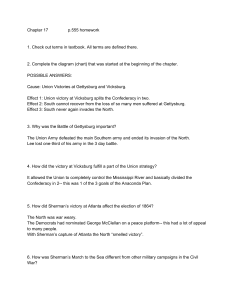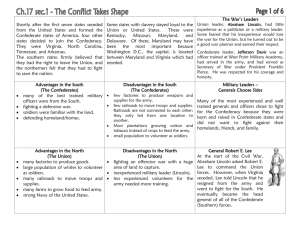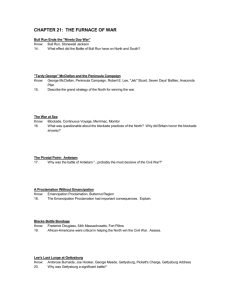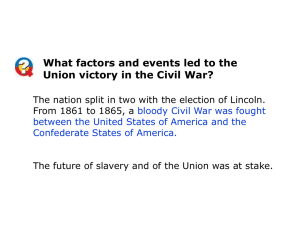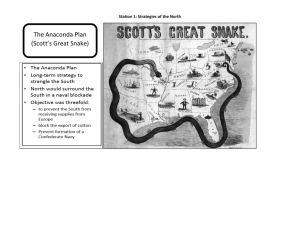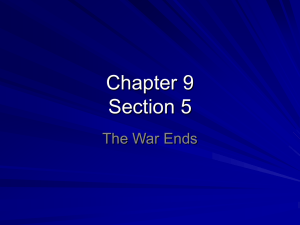IB HOTA
advertisement
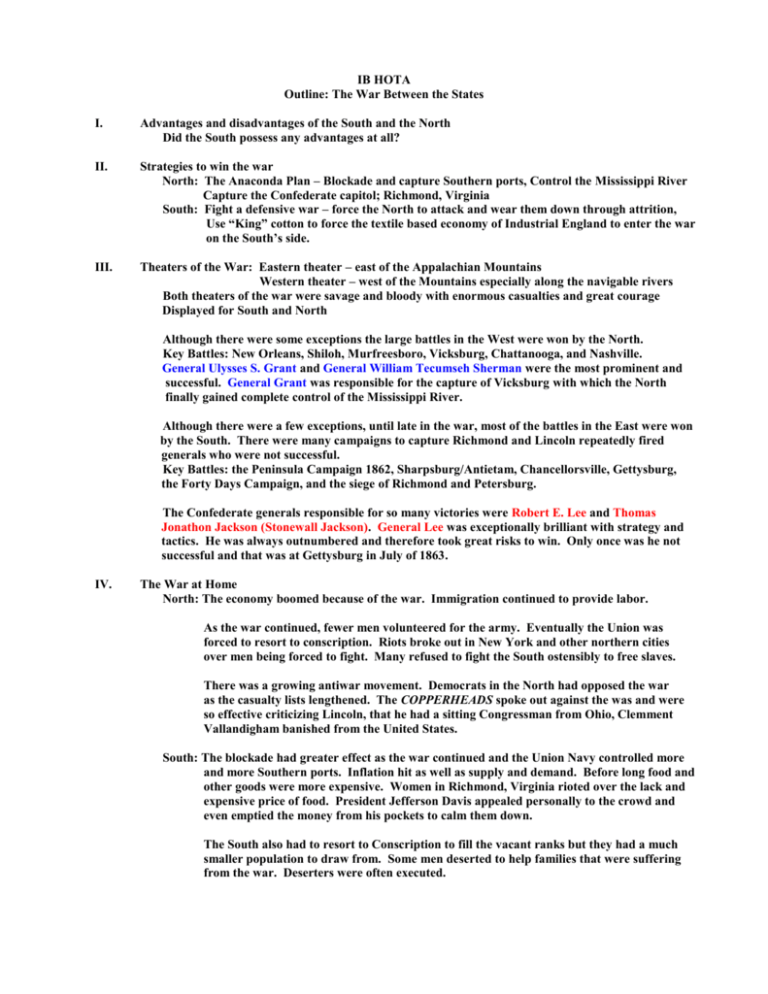
IB HOTA Outline: The War Between the States I. Advantages and disadvantages of the South and the North Did the South possess any advantages at all? II. Strategies to win the war North: The Anaconda Plan – Blockade and capture Southern ports, Control the Mississippi River Capture the Confederate capitol; Richmond, Virginia South: Fight a defensive war – force the North to attack and wear them down through attrition, Use “King” cotton to force the textile based economy of Industrial England to enter the war on the South’s side. III. Theaters of the War: Eastern theater – east of the Appalachian Mountains Western theater – west of the Mountains especially along the navigable rivers Both theaters of the war were savage and bloody with enormous casualties and great courage Displayed for South and North Although there were some exceptions the large battles in the West were won by the North. Key Battles: New Orleans, Shiloh, Murfreesboro, Vicksburg, Chattanooga, and Nashville. General Ulysses S. Grant and General William Tecumseh Sherman were the most prominent and successful. General Grant was responsible for the capture of Vicksburg with which the North finally gained complete control of the Mississippi River. Although there were a few exceptions, until late in the war, most of the battles in the East were won by the South. There were many campaigns to capture Richmond and Lincoln repeatedly fired generals who were not successful. Key Battles: the Peninsula Campaign 1862, Sharpsburg/Antietam, Chancellorsville, Gettysburg, the Forty Days Campaign, and the siege of Richmond and Petersburg. The Confederate generals responsible for so many victories were Robert E. Lee and Thomas Jonathon Jackson (Stonewall Jackson). General Lee was exceptionally brilliant with strategy and tactics. He was always outnumbered and therefore took great risks to win. Only once was he not successful and that was at Gettysburg in July of 1863. IV. The War at Home North: The economy boomed because of the war. Immigration continued to provide labor. As the war continued, fewer men volunteered for the army. Eventually the Union was forced to resort to conscription. Riots broke out in New York and other northern cities over men being forced to fight. Many refused to fight the South ostensibly to free slaves. There was a growing antiwar movement. Democrats in the North had opposed the war as the casualty lists lengthened. The COPPERHEADS spoke out against the was and were so effective criticizing Lincoln, that he had a sitting Congressman from Ohio, Clemment Vallandigham banished from the United States. South: The blockade had greater effect as the war continued and the Union Navy controlled more and more Southern ports. Inflation hit as well as supply and demand. Before long food and other goods were more expensive. Women in Richmond, Virginia rioted over the lack and expensive price of food. President Jefferson Davis appealed personally to the crowd and even emptied the money from his pockets to calm them down. The South also had to resort to Conscription to fill the vacant ranks but they had a much smaller population to draw from. Some men deserted to help families that were suffering from the war. Deserters were often executed. IV. The War Ends: Even though Southern armies were often winning battles, they were losing the war. Northern armies occupied more land in the Confederacy and the South was desperate. The last hope for the South was to get Lincoln’s opponent elected as president in the election of 1864. His opponent was General George McClellan, a Democrat. Because the main Union Army had been so unsuccessful against Lee, except for Gettysburg, Lincoln fired general after general. McClellan had been one of those. Additionally, Lincoln had brought his best general from the Western Theater to beat Lee. That general was Ulysses S. Grant. In the Spring of 1864 a grand campaign was planned to end the war. General Grant would take the main Union Army and beat Lee while General Sherman would command the main Union army in the West and beat the Confederates there. Grant’s 1864 Spring campaign was centered on taking the initiative from Lee and forcing him to defend Richmond, Va. This was known as the “Forty Days.” There was combat for everyday and although Grant did seize the initiative from Lee, Lee beat him in every battle. The Wilderness, Spotsylvania, North Anna River, and Cold Harbor were all Confederate victories. Grant lost 60,000 men in those forty days. Newspapers in the North called him “The Butcher” because of the casualties. However, Grant continued to have the strategic initiative and was forcing Lee backwards to Richmond. But, because the casualty lists were so long, Lincoln’s re-election was threatened because people were weary of the war. General Sherman launched his Spring 1864 campaign with the intent to capture the city of Atlanta, Georgia. He fought a series of battles and seized the strategic initiative from the Confederates as well and eventually forced them back to Atlanta itself. Lincoln’s re-election was still in doubt until General Sherman captured Atlanta. This was a convincing victory and Lincoln was re-elected. After capturing Atlanta, Sherman tried to destroy the Confederate Army that had evacuated Atlanta but was unsuccessful. He decided to march from Atlanta to the sea. He led his army to Savannah and on the war destroyed as much of the infrastructure of the South as he could. Homes, barns, buildings, bridges were burned. Railroads were destroyed. People were forced from their homes and many civilians faced starvation. After capturing Savannah, Sherman turned north to South Carolina and marched to Columbia which his men burned. They continued north into North Carolina and fought a last few battles against the remnant of a Confederate army. Grant finally forced Lee to Richmond and Petersburg, Va. Over a seven month period Grant managed to make Lee stretch his line so thinly that eventually it broke. In April of 1865 Lee was forced to evacuate Richmond and his army was forced westward. Lee was finally surrounded at Appomattox Court House (a small village) on April 9, 1865 and forced to surrender. About two weeks later the next largest remaining army in the Confederacy surrendered at Durham Station, North Carolina to General Sherman. There was some sporadic fighting that continued throughout the Confederacy for another month. The last Confederate general to surrender was a Cherokee Indian Chief named Stand Watie. President Davis and his family with a personal guard fled Richmond as Lee evacuated. He tried to make his way to Texas to carry on the fight but was captured in Georgia. He was never placed on trial and was imprisoned for two years. Lincoln was assassinated on April 14, 1865.

